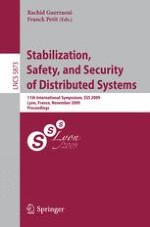This book constitutes the refereed proceedings of the 11th International Symposium on Stabilization, Safety, and Security of Distributed Systems, SSS 2009, held in Lyon, France, in November 2009. The 49 revised full papers and 14 brief announcements presented together with three invited talks were carefully reviewed and selected from 126 submissions. The papers address all safety and security-related aspects of self-stabilizing systems in various areas. The most topics related to self-* systems. The special topics were alternative systems and models, autonomic computational science, cloud computing, embedded systems, fault-tolerance in distributed systems / dependability, formal methods in distributed systems, grid computing, mobility and dynamic networks, multicore computing, peer-to-peer systems, self-organizing systems, sensor networks, stabilization, and system safety and security.
